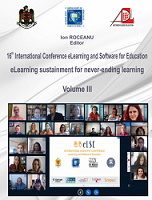HOW EFFICIENT ARE THE WEB-BASED LEARNING METHODS IN ANTIDOPING EDUCATION OF ROMANIAN ELITE ATHLETES?
HOW EFFICIENT ARE THE WEB-BASED LEARNING METHODS IN ANTIDOPING EDUCATION OF ROMANIAN ELITE ATHLETES?
Author(s): Claudia Berbecaru, Monica Stănescu, Andrei MicleiSubject(s): Higher Education , Substance abuse and addiction, Health and medicine and law, Sports Studies, Distance learning / e-learning
Published by: Carol I National Defence University Publishing House
Keywords: e-learning; antidoping; education;
Summary/Abstract: Providing antidoping education is one of the most important characteristics of the specialized institutions in this field. In the past, they focused on actions aimed at testing athletes in order to detect prohibited substances. Currently, the national antidoping agencies, independently or in partnership with different educational institutions (pre-university, university), or with non-formal education entities, have diversified the methods and means by which antidoping education is carried out. Web-based training methods in antidoping education is one of the new trends in this educational field specific to high-performance sport. The obvious benefits of these methods have prompted antidoping organizations worldwide or nationally to develop and use a number of online tools, such as antidoping e-Learning platforms ADel (Alpha, Coach true, Online Sport Physician Kit, Ado Kick Start, Parents' Guide to Support Clean Sport), edu.anad.ro (platform of the Romanian Antidoping Agency ), e-Learning Germany (platform of the German Antidoping Agency), e-Learning England (platform of the Antidoping Agency of England), iLiftClean Education Platform (platform of the International Weightlifting Federation). The paper aims to highlight the level of knowledge of antidoping training programs relying on web-based learning methods, among Romanian athletes. In this regard, a survey (questionnaire) was applied, based on the following: knowledge of online antidoping education tools, the frequency of platform access, and the level of efficiency perceived by the athletes who use them, the advantages and the disadvantages perceived by athletes, etc. The research was carried out on a group of 150 athletes, aged 15-35 years, practicing one of the following sports: athletics, cycling, artistic gymnastics, handball, swimming, judo, wrestling, tennis, volleyball, biathlon, bob, ice hockey, speed skating, sledding, ski jumping, downhill skiing, mountaineering, cross country skiing, snowboarding. The conclusions of the paper highlight a number of particularities of the antidoping education applied to Romanian athletes and allow the formulation of recommendations that will improve the interventions of the NADA educational actions.
Journal: Conference proceedings of »eLearning and Software for Education« (eLSE)
- Issue Year: 16/2020
- Issue No: 03
- Page Range: 346-354
- Page Count: 9
- Language: English

